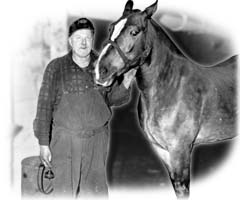



    |
|
|
Ponies
In the early years of coal mining in Cape Breton, the coal industry employed the use of "pit ponies" to haul coal from the mines and later, as the workings progressed, in the mines themselves. Operators of these mines were compelled to use these "ponies" both by considerations of economy and necessity, and their use is said to have been instrumental in making coal mining a success. Generally, the ponies were maritime bred; bought from dealers or farmers, and were by far the most satisfactory class of horse to deal with. They needed some training, but proved easier to train than the Western horse. The selection of the pit pony was a matter of extreme importance and great care was taken. Various characteristics of the horse were weighed before it was choosen for work in the mines. For instance, because of low roofs, steep grades and forced production, a pony must be low set, heavily bodied, heavily limbed with plenty of bone and substance. It must be low-headed and must be "sure-footed" and should not be under five, and possibly not more than 14, years of age. The weight of the animal was important because often heavy loads had to be moved up and down steep grades which, in turn, necessitated sure-footedness because of road conditions. Another consideration was the temperament of the pony. A nervous or shy horse would be very expensive to break in and would cause a great deal of lost time. A good pit horse was one that was even tempered and kind, a vicious horse was a menace to the drivers; liable to cause bodily injury and/or fatal accidents. Stable conditions were very important and as much as possible was done to tend to the comfort of these animals and lengthen their term of usefulness. In the stable, the height of the roof was to be seven feet when a five foot horse was in use. It should be able to raise its head and relax its muscles because it had to work all day carrying its head low. Ventilation should be arranged so that the direct current would not strike the horses. As little wood as possible was used in the construction of the stables to lessen the chance of fire. All stables should be well drained with pipes, and well whites washed for sanitary purposes. The stableman usually shod the horses with shoes made on the surface. Sometimes, a ferrier went into the mine when a higher degree of shoeing skill was required. He would take the measurements, go to the surface, make the shoes and then go back into the pit to shoe the horses. It was desirable that the horse have one driver who would take more pride in the animal and so that they might both understand one another. It is true that a horse's disposition is spoiled when drivers are changed. The horses should have harnesses that fit well and were to be kept clean and oiled to prevent harness sores. Also, no horse should be worked with harness sores. The roadways were to be kept in the best possible condition to prevent accidents. The roof was also to be carefully brushed to rid it of protruding booms and rocks that might cause head injury to the horse. The horses were taken below ground in a cage or were walked into the slope mines on a footpath. Their daily working shift was normally the same as a man's and drivers did not like their ponies to be double-shifted. When the animal got older, their work period was usually reduced to four hours. They generally stayed below ground for approximately five years, unless killed or maimed, and then they were either moved or replaced. 
The work of the horses was as follows: "They pulled material in coal boxes from the shaft or slope bottom to the working places and pulled the filled boxes to the point near the surface, and in the later period to where underground sections converged. They were used in the same manner as railway yard shunting engines..." The efficiency of pit ponies depends upon the manner in which they were treated and the amount of food they received. A man (stableman) was hired to take charge of the underground stable and also to take care of and feed the horses. Usually, an hour before work, they were fed hay, watered and grained. The horses were given one pound of hay and grain per day for 100 pounds of flesh. For example: a 1,000 pound horse would be fed 10 pounds of hay and 10 pounds of grain. The grain was a combination of 2 parts oats, 1 part corn, and 1 part bran and had to be of the best quality. When the horse was idle, the amount of hay was increased and given twice a day; the grain ration was reduced 1/3 to 1/2 according to the horse's physical condition. A constant supply of pure water was considered one of the best investments possible in animal care. At each landing a generous supply of clean water was placed where it would always be available for the horse. This would prevent gorging and eliminate many ailments that often proved fatal. |
|
The History |
The Future
Regional Impact | Mining Techniques | The Museum Main | Glossary | Site Map | Text Only |

Created by Virtual Media Productions Ltd., © 1997.
|